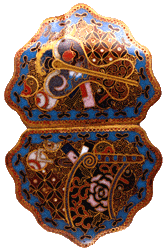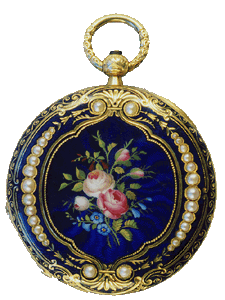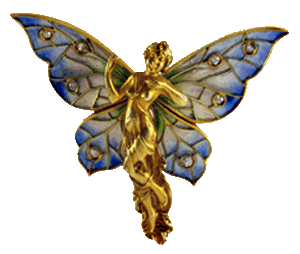Enamel Jewelry
>> Wednesday, January 21, 2009
Enameling is the fusion of a special powdered glass to metals. This is done using different techniques, but all methods use heat to melt the powder.
Enamelling is the ancient and difficult art of creating beautiful images with finely crushed glass powders. Often the enamelist's "canvas" is a jewel or objet d'art. The enamelist "paints" a surface of the jewel with the crushed glass and, through repeated applications and firings, creates wonderful miniature works of art.
The first known enamels were created in ancient Egypt (circa 1500 BC), the art of painting in glass has been practiced throughout the centuries. Over time there has been a lot of changes in the history, fashion and available technologies. Today many of the historical techniques are being revived by contemporary jewelry designers and artisans.
Three of the most beautiful enamelling techniques are: cloisonné, guilloché and plique-à-jour. A brief review of each of these schools of enamelling follows.
Cloisonné - It is the oldest method of enamelling. It was first practiced by the ancient Egyptians, cloisonné enamelling has been embraced by many ancient and modern cultures. First, a network of "cloisons" (cells or compartments) is formed by attaching thin metal wires to a metal surface, like the top of a jewel. Crushed glass enamels of various colors and optical properties are then placed in the various cells.

Above is pictured a Japanese belt buckle, created circa 1900
Guilloché, from the French for engine turning, is the art of engraving intricate circular patterns onto a metal surface. In guilloché enamelling an engine-turned surface is painted with a translucent enamel.

Pictured above is an exquisite enamelled watch created during the 1840's.
Plique-à-jour is one of the most beautiful and most difficult enamelling techniques. The results of plique-à-jour enamelling are stunning. Like cloisonné enamelling, plique-à-jour begins with a lattice of thin metal bands. The cloisons between the metal bands are filled with transparent enamels, but, unlike cloisonné, there is no metal backing.

Above picture is American, circa 1900 in 14kt gold.
Some of Enamel Jewelry :

This Sterling Silver Enamel Earring features black and green enamel to create a beautifully crafted sterling silver earring. The black enamel brings an extra shine to the sterling silver and green adds an extra twinkle to this earring. People will be sure to notice your impecable taste in jewelry when you are wearing this black and green sterling silver enamel earring.

This Sterling Silver Enamel Earring is a lovely and a heartbreaking piece. It has black and blue floral touch on the blue base. You”ll love the look this handcrafted enamel earrings and give you a stunning and trendy look.
 GORGEOUS Sterling Silver Enamel Stud Earring. These earrings are very lovely and brilliant. For pierced ears, they have very comfortable backs. They are very rich looking and beautifully handcrafted with colorful enamel. They look gorgeous when worn. Very comfortable and easy to wear.
GORGEOUS Sterling Silver Enamel Stud Earring. These earrings are very lovely and brilliant. For pierced ears, they have very comfortable backs. They are very rich looking and beautifully handcrafted with colorful enamel. They look gorgeous when worn. Very comfortable and easy to wear.
Enamelling is the ancient and difficult art of creating beautiful images with finely crushed glass powders. Often the enamelist's "canvas" is a jewel or objet d'art. The enamelist "paints" a surface of the jewel with the crushed glass and, through repeated applications and firings, creates wonderful miniature works of art.
The first known enamels were created in ancient Egypt (circa 1500 BC), the art of painting in glass has been practiced throughout the centuries. Over time there has been a lot of changes in the history, fashion and available technologies. Today many of the historical techniques are being revived by contemporary jewelry designers and artisans.
Three of the most beautiful enamelling techniques are: cloisonné, guilloché and plique-à-jour. A brief review of each of these schools of enamelling follows.
Cloisonné - It is the oldest method of enamelling. It was first practiced by the ancient Egyptians, cloisonné enamelling has been embraced by many ancient and modern cultures. First, a network of "cloisons" (cells or compartments) is formed by attaching thin metal wires to a metal surface, like the top of a jewel. Crushed glass enamels of various colors and optical properties are then placed in the various cells.

Above is pictured a Japanese belt buckle, created circa 1900
Guilloché, from the French for engine turning, is the art of engraving intricate circular patterns onto a metal surface. In guilloché enamelling an engine-turned surface is painted with a translucent enamel.

Pictured above is an exquisite enamelled watch created during the 1840's.
Plique-à-jour is one of the most beautiful and most difficult enamelling techniques. The results of plique-à-jour enamelling are stunning. Like cloisonné enamelling, plique-à-jour begins with a lattice of thin metal bands. The cloisons between the metal bands are filled with transparent enamels, but, unlike cloisonné, there is no metal backing.

Above picture is American, circa 1900 in 14kt gold.
Some of Enamel Jewelry :

This Sterling Silver Enamel Earring features black and green enamel to create a beautifully crafted sterling silver earring. The black enamel brings an extra shine to the sterling silver and green adds an extra twinkle to this earring. People will be sure to notice your impecable taste in jewelry when you are wearing this black and green sterling silver enamel earring.

This Sterling Silver Enamel Earring is a lovely and a heartbreaking piece. It has black and blue floral touch on the blue base. You”ll love the look this handcrafted enamel earrings and give you a stunning and trendy look.
 GORGEOUS Sterling Silver Enamel Stud Earring. These earrings are very lovely and brilliant. For pierced ears, they have very comfortable backs. They are very rich looking and beautifully handcrafted with colorful enamel. They look gorgeous when worn. Very comfortable and easy to wear.
GORGEOUS Sterling Silver Enamel Stud Earring. These earrings are very lovely and brilliant. For pierced ears, they have very comfortable backs. They are very rich looking and beautifully handcrafted with colorful enamel. They look gorgeous when worn. Very comfortable and easy to wear.